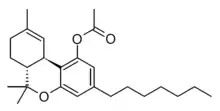THCP-O-acetate
 | |
| Identifiers | |
|---|---|
IUPAC name
| |
| Chemical and physical data | |
| Formula | C25H36O3 |
| Molar mass | 384.560 g·mol−1 |
| 3D model (JSmol) | |
SMILES
| |
THCP-O-acetate (THCP-O) is a semi-synthetic derivative of tetrahydrocannabiphorol (THCP) derived by acetylation of the OH group. It has been found as a component of grey-market cannabis products such as e-cigarette liquids and edible gummy lollies, and is allegedly a potent and long-lasting psychoactive cannabinoid.[1]
Toxicity
In 2022, researchers at Portland State University who screened for the presence of reacted ketene as N-benzylacetamide reported that Vitamin E acetate, CBD-acetate, CBN-acetate and THC-O-acetate may break down to release ketene gas when heated at 340 °C (644 °F).
Legality
Japan banned THCP-O-Acetate along with HHCP on December 26, 2023.[2]
See also
References
- ↑ Erickson BE (2023). "Waiting for CBD regulations in the US". Chemical & Engineering News. 101 (28): 17–19. doi:10.1021/cen-10128-feature1. S2CID 261318144.
- ↑ "Japan bans sale of 38 goods with synthetic cannabis compounds". 22 December 2023.
This article is issued from Wmcloud. The text is licensed under Creative Commons - Attribution - Sharealike. Additional terms may apply for the media files.